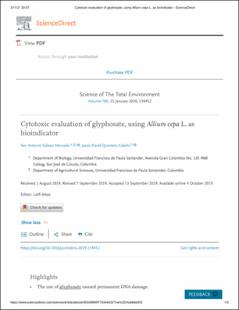Cytotoxic evaluation of glyphosate, using Allium cepa L. as bioindicator
...
SALAZAR MERCADO, SEIR ANTONIO | 2020-01-15
Glyphosate is a chemical compound used mainly as a broad spectrum herbicide, it is recognized for its proven effectiveness and easy handling. It represents more than 60% of the world market of non-selective herbicides and is used in both agricultural fields and family gardens. The present study was designed to test the cytogenotoxic potential of glyphosate using the Allium cepa test as toxicity bioindicator. Consequently, bulbs of A. cepa were exposed to different concentrations of glyphosate (5, 10, 15, 25 and 30 mgL−1) and a control (deionized water), for 72 h; root development was also studied in this period of time. The cytogenotoxic potential of glyphosate was determined by calculating the mitotic index (MI), cellular anomalies (CA) and registering the roots longitudinal growth at 24, 48 and 72 h. Regarding root development, a greater growth was observed in the control treatment in the three measurement times. The mitotic phases analysis, determined that the higher the concentration, the lower the mitotic index, in addition the inhibition of the telophase Mitotic Index (TMI) was observed in any of the concentrations. The results indicate that the exposure to glyphosate of A. cepa meristematic cells induces diverse types of chromosomal anomalies, such as micronuclei (MN), chromosome breaking (CB), nuclear notch (Nn), among others. Therefore, in demonstrates that glyphosate has a highly cytogenotoxic effect for any of the concentrations used.
LEER










